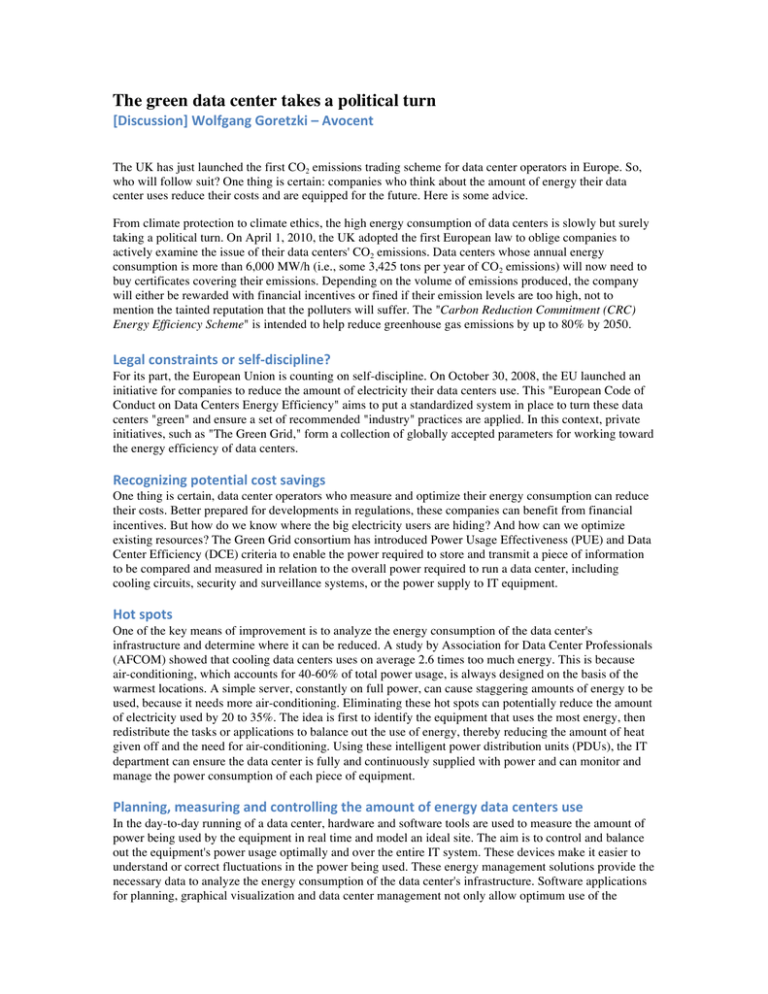Document 11070157
advertisement

The green data center takes a political turn [Discussion] Wolfgang Goretzki – Avocent The UK has just launched the first CO2 emissions trading scheme for data center operators in Europe. So, who will follow suit? One thing is certain: companies who think about the amount of energy their data center uses reduce their costs and are equipped for the future. Here is some advice. From climate protection to climate ethics, the high energy consumption of data centers is slowly but surely taking a political turn. On April 1, 2010, the UK adopted the first European law to oblige companies to actively examine the issue of their data centers' CO2 emissions. Data centers whose annual energy consumption is more than 6,000 MW/h (i.e., some 3,425 tons per year of CO2 emissions) will now need to buy certificates covering their emissions. Depending on the volume of emissions produced, the company will either be rewarded with financial incentives or fined if their emission levels are too high, not to mention the tainted reputation that the polluters will suffer. The "Carbon Reduction Commitment (CRC) Energy Efficiency Scheme" is intended to help reduce greenhouse gas emissions by up to 80% by 2050. Legal constraints or self-­‐discipline? For its part, the European Union is counting on self-discipline. On October 30, 2008, the EU launched an initiative for companies to reduce the amount of electricity their data centers use. This "European Code of Conduct on Data Centers Energy Efficiency" aims to put a standardized system in place to turn these data centers "green" and ensure a set of recommended "industry" practices are applied. In this context, private initiatives, such as "The Green Grid," form a collection of globally accepted parameters for working toward the energy efficiency of data centers. Recognizing potential cost savings One thing is certain, data center operators who measure and optimize their energy consumption can reduce their costs. Better prepared for developments in regulations, these companies can benefit from financial incentives. But how do we know where the big electricity users are hiding? And how can we optimize existing resources? The Green Grid consortium has introduced Power Usage Effectiveness (PUE) and Data Center Efficiency (DCE) criteria to enable the power required to store and transmit a piece of information to be compared and measured in relation to the overall power required to run a data center, including cooling circuits, security and surveillance systems, or the power supply to IT equipment. Hot spots One of the key means of improvement is to analyze the energy consumption of the data center's infrastructure and determine where it can be reduced. A study by Association for Data Center Professionals (AFCOM) showed that cooling data centers uses on average 2.6 times too much energy. This is because air-conditioning, which accounts for 40-60% of total power usage, is always designed on the basis of the warmest locations. A simple server, constantly on full power, can cause staggering amounts of energy to be used, because it needs more air-conditioning. Eliminating these hot spots can potentially reduce the amount of electricity used by 20 to 35%. The idea is first to identify the equipment that uses the most energy, then redistribute the tasks or applications to balance out the use of energy, thereby reducing the amount of heat given off and the need for air-conditioning. Using these intelligent power distribution units (PDUs), the IT department can ensure the data center is fully and continuously supplied with power and can monitor and manage the power consumption of each piece of equipment. Planning, measuring and controlling the amount of energy data centers use In the day-to-day running of a data center, hardware and software tools are used to measure the amount of power being used by the equipment in real time and model an ideal site. The aim is to control and balance out the equipment's power usage optimally and over the entire IT system. These devices make it easier to understand or correct fluctuations in the power being used. These energy management solutions provide the necessary data to analyze the energy consumption of the data center's infrastructure. Software applications for planning, graphical visualization and data center management not only allow optimum use of the available capacity, but they also allow a dynamic plan to be created for the data center. Rather than waiting for instructions from the legislators, it is in the best interest of companies to start reducing, from today, their energy consumption and their CO2 to get a head start on the competition. And, because these companies will hold all the cards, they may perhaps avoid being subject to regulations imposed by the State in their journey toward eco-responsibility. By Wolfgang Goretzki, EMEA Product Marketing Director, Avocent











